Past Program
Writing Enrichment 1: Persuasive Writing
It can sometimes be difficult for students to write exactly why they covet something highly desirable and popular, aside from the usual reason of peer pressure. In this persuasive letter to his father, Jonathan gives specific details to back up his reasons for wanting such an item. The consequences of not having it are written with flair and personality.
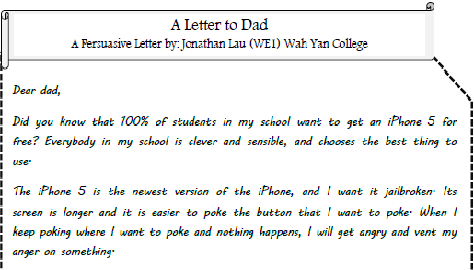
Read PDF
Program:
Writing Enrichment
Jonathan Lau
F2, Wah Yan College KL
Writing Foundation 2: Descriptive Writing
In the module Descriptive Writing, our WF2 students learned several techniques they could use to give life to their descriptions. Laetitia not only did that, but also added a wealth of anecdotes and picked the most special thoughts and feelings to write about. The depth of the piece is a huge improvement, and makes it a very personalized piece indeed.
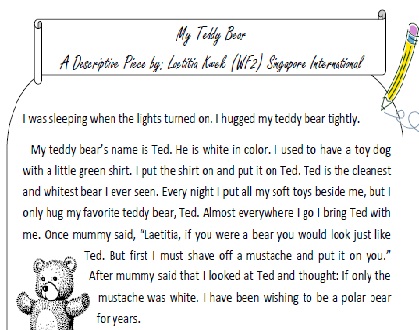
Read PDF
Program:
Writing Foundation
Laetitia Kwek
G3, SIS
Writing Foundation 3: Fiction
During term 2, students learnt about fictional writing and were taught how to plan a story with the use of a story roller coaster. This method is useful for the students at this level as it encouraged better organization of ideas by pushing students to think through each section of the story in more detail. As a result, the finished product turns out to be more coherent and logical. Students were taught how to write with clear nouns and precise adjectives, avoiding the use vague words such as “something” or “stuff”.
It is apparent from Davis’ finished piece that he applied these newly acquired techniques very well. He wrote with precision and demonstrated his creativity through his choice of words and story content, creating vivid mental images for most of his scenes. Take a look at his exciting tale, "Pomeranian Devil", by clicking the PDF link below!
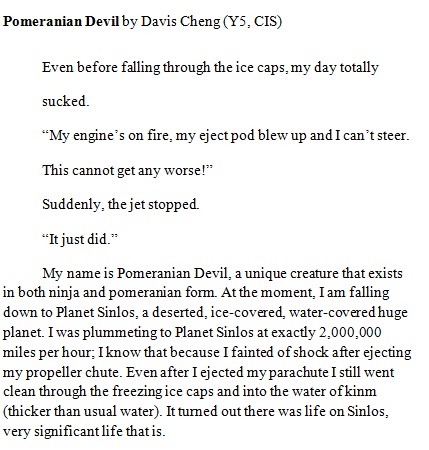
Read PDF
Program:
Writing Foundation
Davis Cheng
Y5, CIS
Writing Foundation 2: Descriptive Writing
Students were taught:
- Writing Technique: How to utilize a mind-map, apply 3 different lenses to the 5-senses, describe colors more creatively, give life to objects by assigning them actions, narrow down and arrange ideas,
- Vocabulary and Grammar: How to specify word choice, utilize alliterations and reference a thesaurus
- Reading Comprehension: Students read a large variety of texts that described everything from windows and bathrooms, to magical new worlds. Comprehension questions challenged students to apply their imaginations and inference skills.
Ashley has always impressed with her great work ethic and practicality, but we were so pleased to witness her imagination really came through during the descriptive wriitng unit. Check out her wonderfully colorful descriptive piece in which she describes her beloved harp by clicking the PDF link below!
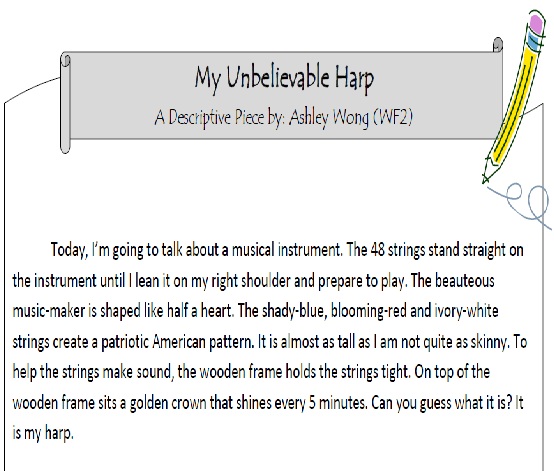
Read PDF
Program:
Writing Foundation
Ashley Wong
P4, St. Stephens College
Writing Foundation 1: Fiction
Students were taught:
- What is Fiction vs. Nonfiction
- Fiction story planning: brainstorming concepts, selecting a specific and descriptive time and place (setting), creating a main character and identifying their descriptive characteristics, mapping key events in a fiction story with an emphasis placed on writing in the past tense – the problem, the solution, the conclusion.
- Writing technique: writing a story based on a picture using select action verbs, proper use of speech/quotation marks, strong introductions, self-correcting with a focus on replacing “then” with other transition words
- Vocabulary and grammar: action verbs, using stronger synonyms of common action verbs, past and present tense, regular and irregular past tense verbs, past tense of “to be” words
- Reading Comprehension: answering a blend of direct, inference, and opinion questions about the readings
Hannah is a returning student from our summer writing program. She has made such immense improvement since she first started attending classes at The Open Classroom, we couldn't resist sharing her latest creation! Click the PDF link below to check out Hannah's magical fiction-tale!
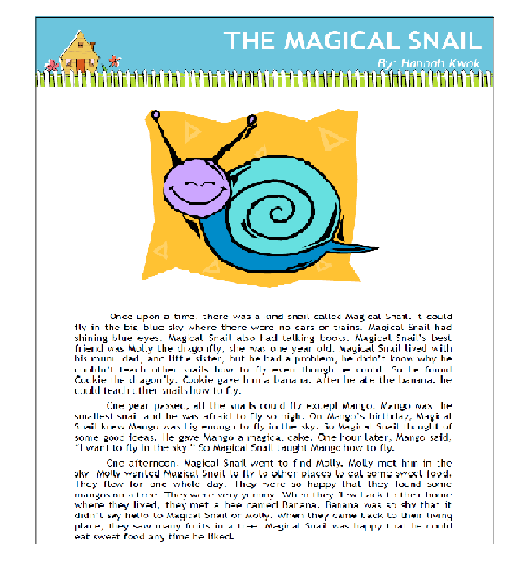
Read PDF
Program:
Writing Foundation
Hannah Kwok
P2, DGJS
Writing Enrichment 1: Character Sketch
Students were taught:
- How to design a character sketch using figures of speech and different methods of statements that “show”, not “tell”: what the character’s habits are, their catchphrases,and why this person is important to the students; avoiding lists of adjectives
- Inserting character descriptions in a fictional or semi-fictional narrated scene that displays his/her personality
- Ways to introduce a character: state a belief/opinion/feeling, use a dialogue, describe the setting, or use a flashback
- How different settings may create different moods as a backdrop for the character described
- Ways to end the narrative: use a dialogue, state a feeling/reflection, describe a setting or use a question
Our Writing Enrichment 1 students all worked hard during the first part of Regular Term 1 2012, but here is one particularly noteworthy character sketch by Jonathan!
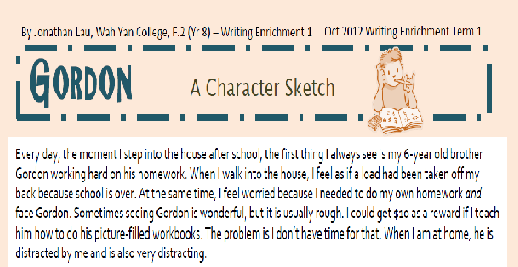
Read PDF
Program:
Writing Enrichment
Jonathan Lau
Form 2, Wah Yan College
Writing Foundation 3: Detective Stories
Students were taught:
- The major components of writing a detective story – crime outline, motive, method, clues, suspects, climax and resolution
- The writing process from designing the crime, crafting and outlining the plot to drafting and revising their story
- Writing technique: Effective dialogues and action words; Importance of character development through introduction of the protagonist, numerous suspects, and development of plot through clues, climax and resolution.
- Vocabulary and Comprehension skills: Students read extracts from other detective stories and mysteries and analyzed how the authors wrote with purposeful dialogues, used strong verbs and descriptive words, and built suspense.
Check out one stellar writer's final detective story output below!
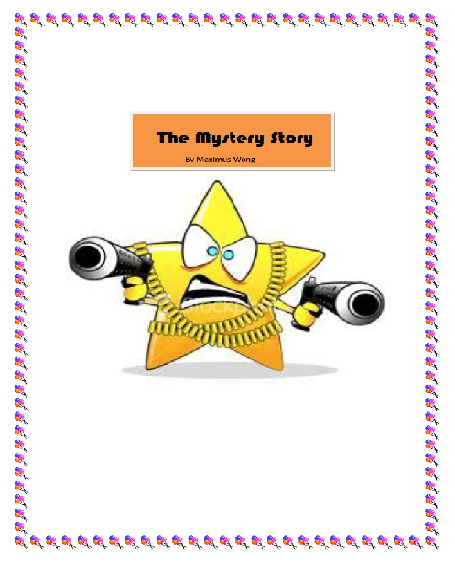
Read PDF
Program:
Writing Foundation
Max Wong
P5, St. Paul\'s Co-Ed
Writing Foundation 1: Journals
Students were taught:
- What makes a journal entry unique from other compositions (1st person, incorporation of feelings, past tense)
- Detailed writing/story planning
- Desriptive writing techniques (adjective and strong verbs use)
The students recounted a memorable day from their past experiences in journal form. Take a look at Jamie's illustrated tale about her trip to Disneyworld and the acquisition of her new imaginary friend!
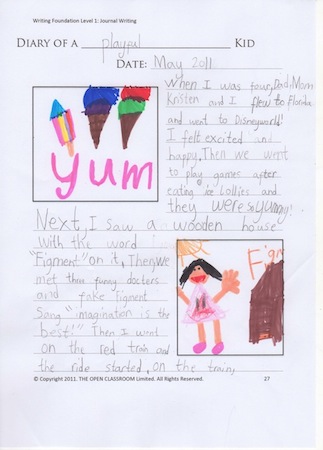
Read PDF
Program:
Writing Workshop
Jamie Chim
K3, SKH Kindergarten
Writing Foundation 1: Animal Stories
Students were taught:
- information about different animals around the world
- brainstorming and outlining stories
- parts of a story (introduction, development, resolution)
- editing skills
Read PDF
Program:
Writing Foundation
Claudia Woo
1, GSIS
Writing Enrichment 2: Setting Sketches
Students were taught:
- Describing a place using vivid details based on the five senses
- Connecting the description of a place to memories and personal significance